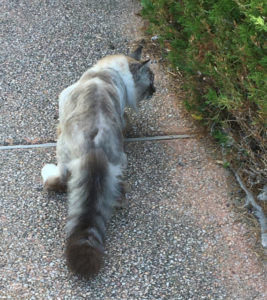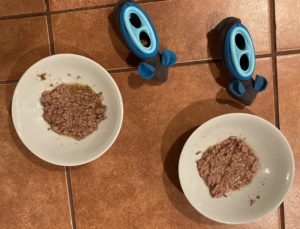In my job as a veterinary technician, owners often tell me “I can’t train my cat – food does not motivate my cat ”. ” My cat won’t eat his medication in a treat – he doesn’t like treats”.
Like people, cats are individuals – some are grazers and others will eat at any time. BUT… all domestic cats share common ancestry -Felis Libyca, the African Wildcat – and they have inherited a certain physiology.
The Behavior of Feeding

- Cats have small stomachs and a short GI tract designed to digest meat.
- They cannot wait until they get hungry to hunt – they will starve if they do.
- Their lifestyle is one of being on the prowl most of their waking hours, looking for food
- CATS ARE HARD-WIRED TO HUNT
- “NEW PREY” IS A STRONG MOTIVATION
The free-roaming cat eats up to 8-10 meals daily. The number of meals depends on the size of the meal – it will take a bit longer to digest a rabbit than a few bugs!
You say “Food does not motivate my cat”? What if we try to mimic the prowling feeding style of the wild cat?
Feeding 4+ Meals a Day
How much to feed?

What your cat will eat in one sitting.
- watch your cat – pick up and measure the food eaten when he leaves the bowl -OR-
- offer a “2 mouse” meal of about 50 kcal
Feeding 4+ meals if you are not home during the day
- AM: meal feed: canned or dry food
- DAY: (2) food puzzles with dry food
- PM meal feed: canned or dry food
- Snack at bedtime: Treats for training or play
How to Do It:
Use puzzle feeders/timed feeders
- each puzzle has a “two mouse” meal
- timed feeders with “two mouse” meals
- some feeders can hold ice packs for canned food
- “timed” puzzle feeders
Food Security in Multi-Pet Households
My dog will eat the food puzzles
- Food puzzles in boxes
- Food puzzles in closets
- Feed on counter or high places
My other cat will eat all the food
- Use a microchip feeder Surefeeder
- Feeding on different levels
- Isolate cats when not at home

